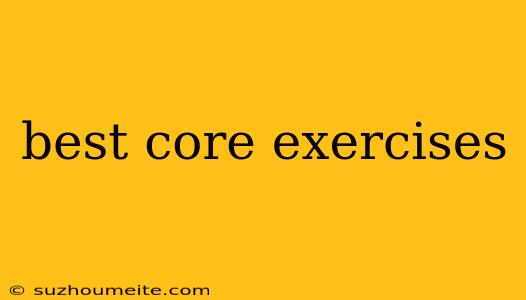Best Core Exercises for a Strong and Stable Body
Your core isn't just your abs. It's a complex network of muscles that includes your back, hips, and glutes, all working together to provide stability, balance, and power for your entire body. Strong core muscles are essential for everyday activities, from lifting groceries to playing sports. They also help prevent injuries, improve posture, and even boost your metabolism.
Here are some of the best core exercises that will help you build strength and stability:
Beginner-Friendly Core Exercises
-
Plank: This isometric exercise is a great way to engage all your core muscles simultaneously.
- Start in a push-up position with your forearms on the ground and your body forming a straight line from your head to your heels.
- Hold this position for 30 seconds or as long as you can maintain good form.
- Gradually increase the hold time as you get stronger.
-
Bird Dog: This exercise challenges your balance and strengthens your core, back, and glutes.
- Start on your hands and knees, with your back flat and your core engaged.
- Extend one arm and the opposite leg out simultaneously, keeping your back straight.
- Hold for a few seconds, then return to the starting position.
- Repeat on the other side.
-
Knee-to-Chest: This simple exercise works your core muscles and improves flexibility.
- Lie on your back with your knees bent and your feet flat on the ground.
- Bring one knee towards your chest, hugging it with both hands.
- Hold for a few seconds, then slowly lower your leg back to the starting position.
- Repeat on the other side.
Intermediate Core Exercises
-
Crunches: Crunches target your upper abdominal muscles.
- Lie on your back with your knees bent and your feet flat on the ground.
- Place your hands behind your head, keeping your elbows wide.
- Curl your upper body up towards your knees, engaging your core.
- Lower back down slowly, maintaining control throughout the movement.
-
Russian Twists: This exercise works your obliques, which are the muscles on the sides of your abdomen.
- Sit on the ground with your knees bent and your feet flat on the ground.
- Lean back slightly, keeping your core engaged.
- Twist your upper body from side to side, touching the ground on each side with your hands.
-
Dead Bug: This exercise challenges your core stability while strengthening your entire body.
- Lie on your back with your knees bent at 90 degrees and your hips flexed at 90 degrees.
- Extend one arm straight up towards the ceiling and the opposite leg straight out towards the floor.
- Slowly lower the arm and leg towards the ground, keeping your back flat and your core engaged.
- Repeat on the other side.
Advanced Core Exercises
-
Hanging Leg Raises: This exercise is a great way to build strength in your lower abdominal muscles.
- Hang from a pull-up bar with your arms fully extended.
- Raise your legs straight up towards the ceiling, keeping your core engaged.
- Slowly lower your legs back down to the starting position.
-
Anti-Rotation Press: This exercise challenges your core to resist twisting forces.
- Stand with your feet shoulder-width apart, holding a weight in one hand.
- Push the weight overhead while keeping your body stable and resisting the urge to rotate your torso.
-
Side Plank: This isometric exercise strengthens your obliques and improves stability.
- Start in a forearm plank position with your body in a straight line.
- Rotate your body to one side, balancing on your forearm and the side of your foot.
- Hold this position for 30 seconds or as long as you can maintain good form.
- Repeat on the other side.
Tips for Effective Core Training
- Focus on proper form: Always prioritize proper form over weight or repetitions.
- Engage your core throughout: Engage your core muscles throughout all exercises, even those that aren't explicitly targeting the core.
- Breathing: Exhale as you perform the most challenging part of the exercise.
- Progressive overload: Increase the difficulty of your exercises gradually as you get stronger.
Remember to listen to your body and rest when needed. With consistent effort and dedication, you can build a strong and stable core that will support you for years to come.
